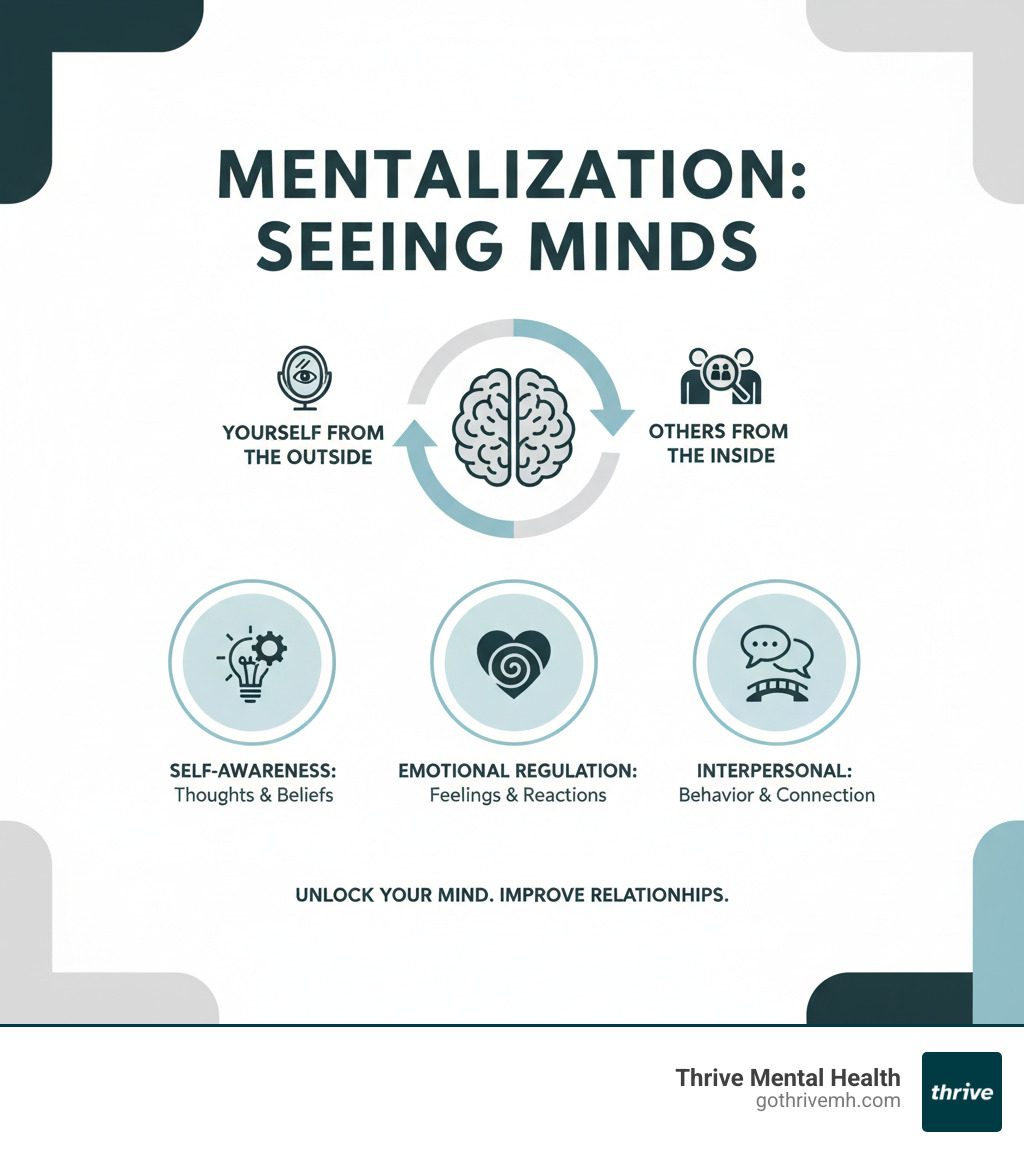Mentalization-Based Therapy Worksheets: Your Guide to Better Mental Health

If youre thinking about suicide, self-harm, or feel unsafe, call or text 988 (US) now for the Suicide & Crisis Lifeline. If youre outside the US, call your local emergency number.
[Callout] If youre in crisis, call/text 988 right now. You are not alone.
Mentalization-Based Therapy Activities [2025]: 10 Proven Tools to Stop Blowups, Understand Others, and Feel Steadier0Fast
Mentalization-based therapy activities are step-by-step exercises to help you defuse conflict fast, read others intentions more accurately, and steady your emotions. Use these 10 practical tools to build insight, improve relationships, and feel more in control.
Mentalization-based therapy activities are exercises designed to help you understand the thoughts and feelings behind your actions and the actions of others. They range from simple journaling to interactive games that build emotional awareness and stronger relationships.
Quick Reference: Core MBT Activities
- Thinking and Feeling Diary – Track emotional patterns and triggers
- Movie Character Exercise – View situations from an outside perspective
- Back-to-Back Drawing – Practice clear communication skills
- Relationship Mapping – Visualize your social connections
- Dream Journey – Create a mental safe space for difficult emotions
Imagine stepping back to watch your own reactions like a character in a movie. Mentalization gives you the power to understand the “why” behind behaviorsboth yours and others’. This skill is incredibly powerful. Research shows that people who learned mentalization through MBT had 80% fewer emergency room visits and showed relationship improvements that lasted for years after treatment.
Whether you’re dealing with intense emotions or relationship conflicts, these activities offer a practical, accessible path forward without complex theories. I’m Anna Green, LMHC, LPC. In my clinical practice, I’ve used these evidence-based tools to help countless clients build emotional regulation and more secure relationships.

Key terms for mentalization-based therapy activities:
What is Mentalization-Based Therapy (MBT)?
Think of mentalization as your mind’s GPS for relationships. It’s the ability to make sense of behavior—both your own and others’—by seeing the thoughts, feelings, and needs driving it. When you wonder, “Why did they do that?” or “What was I feeling just now?” you’re mentalizing. It’s about seeing yourself from the outside and others from the inside.
While it sounds like common sense, this ability can go offline when we’re stressed or overwhelmed. Mentalization-Based Therapy (MBT) is designed to strengthen this capacity through structured mentalization-based therapy activities.
The approach is built on a few core principles. Therapists adopt a “not-knowing stance,” approaching your experience with genuine curiosity rather than assumptions. This creates a safe space for exploration. Empathy is also key, as the therapist works to reflect your internal experience, helping you feel seen and validated.
MBT has roots in attachment theory, recognizing that our ability to mentalize develops in early relationships. If these attachments were insecure, MBT helps repair them by creating a secure therapeutic relationship where you can safely explore your inner world. Research shows how MBT helps with attachment issues by providing this secure base. From its psychodynamic roots, MBT uses the therapeutic relationship itself as a tool to practice understanding mental states in real-time.
If you’re wondering how MBT fits with other therapy approaches, we have more info about different therapy types to help you understand your options.
The Core Goal: Stabilizing Your Sense of Self
The ultimate aim of MBT is to stabilize your sense of self and improve how you steer life. A strong mentalizing capacity leads to:
- Clearer self-understanding: You recognize your emotions, triggers, and motivations.
- Better understanding of others: You can more accurately interpret others’ behavior.
- Fewer misunderstandings: You can pause and consider other perspectives instead of assuming the worst.
- Greater emotional stability: You can step back from intense emotions and analyze them.
- Awareness of impact: You learn to distinguish between your good intentions and your actual impact on others.
How MBT Differs from DBT and CBT
While many therapies help, MBT is distinct from Dialectical Behavior Therapy (DBT) and Cognitive Behavioral Therapy (CBT). Think of it this way: MBT focuses on the “why,” DBT focuses on the “how,” and CBT focuses on the “what.”
| Feature | Mentalization-Based Therapy (MBT) | Dialectical Behavior Therapy (DBT) | Cognitive Behavioral Therapy (CBT) |
|---|---|---|---|
| Primary Focus | Understanding mental states (thoughts, feelings, intentions) of self and others | Teaching concrete skills for emotion regulation and interpersonal effectiveness | Identifying and changing unhelpful thought patterns and behaviors |
| Core Question | “Why did I/they feel/act that way?” | “How can I manage this emotion effectively?” | “What am I thinking, and how can I change it?” |
| Key Techniques | Curiosity, empathy, exploration through the therapeutic relationship | Skills training, mindfulness, distress tolerance | Thought challenging, behavioral experiments, exposure |
| Main Goal | Stabilize sense of self and improve relationships through better understanding | Reduce harmful behaviors and improve emotional control | Change maladaptive thoughts and behaviors to reduce symptoms |
MBT’s unique strength is helping you understand the complex mental states driving behavior. While other therapies teach you what to do or how to cope, MBT helps you understand why you and others react the way you do, leading to more lasting change.
For a deeper exploration of these differences, particularly between MBT and CBT, check out our detailed comparison: MBT vs. CBT.
10 Powerful Mentalization-Based Therapy Activities to Practice

Mentalization-based therapy activities are practical tools to improve your mentalizing skills, connect with your inner world, and strengthen relationships. They are particularly effective for conditions like Borderline Personality Disorder (BPD), where emotional intensity can make mentalizing difficult.
If you are in crisis, please call or text 988 immediately. Support is available.
The evidence for MBT is compelling. A randomized controlled trial found that patients receiving MBT had significant, long-term reductions in suicidality, self-harm, hospitalization, and distress, with improved social skills even 8 years after treatment. These activities provide a structured way to practice and build these skills.
1. The “Thinking and Feeling” Diary
This foundational journaling exercise builds self-awareness. Each day, take 15-20 minutes to reflect on a significant event.
How it works: Write down:
- The event: What happened and who was there?
- Your thoughts & emotions: What went through your mind? What did you feel (rate intensity 1-10)?
- The connection: How did your thoughts and feelings influence your behavior?
- Alternatives: Could you have seen or responded to the situation differently?
This practice helps you identify triggers and understand your emotional patterns.
2. The “Movie Character” Exercise
This activity helps you gain perspective by stepping outside yourself.
How it works: Recall a recent challenge. Imagine watching it as a movie scene. Describe your own actions as if you were a character.
- Narrate: What would a neutral observer say about the character’s behavior?
- Analyze: What might the character have been thinking or feeling?
- Understand impact: How did the character’s behavior affect others in the scene?
This helps you detach from intense emotions and analyze your motivations and impact.
3. The “Back-to-Back Drawing” Activity
This interactive activity for pairs or families highlights how easily misunderstandings happen.

How it works: Two people sit back-to-back. One person (the “speaker”) describes a simple drawing. The other (the “drawer”) tries to recreate it based only on the verbal description. Afterward, compare the drawings.
Reflection: Discuss what was frustrating, what went well, and where communication broke down. This playfully shows how assumptions lead to misinterpretations and highlights the importance of clear communication. It’s a great example of how art can improve therapy.
4. The Mentalization Model Worksheet
This worksheet improves understanding of interpersonal relationships.
How it works: Choose an important relationship.
- Your perspective: Identify your feelings, needs, and goals for the relationship.
- Their perspective: Imagine the other person’s feelings, needs, and goals.
- Overlap and differences: Where do your perspectives align and differ?
This exercise, available from resources like the Center for Mentalization, helps you step into another’s shoes. You can download the Mentalization Model activity for a structured approach.
5. The “Triune Brain” Psychoeducation
Understanding how your brain works is empowering. This activity uses a simplified model of the brain.
How it works: Learn about the three main parts:
- Reptilian Brain (Survival): Fight, flight, freeze instincts.
- Mammalian Brain (Emotional): Emotions, social bonding.
- Neocortex (Executive): Logic, planning, and mentalization.
Application: Under stress, our survival brain can take over, making it hard to mentalize. Recognizing this helps you understand impulsive reactions in yourself and others. The goal is to learn to identify these states and shift back to your executive brain.
6. The “Dream Journey” for a Safe Space
This guided imagery exercise creates internal calm, which is necessary for mentalizing.
How it works: In a quiet place, close your eyes and imagine a safe, pleasant place. A therapist or recording guides you to focus on sensory details (sights, sounds, smells).
Benefits: This reduces tension and creates a mental “safe space” you can return to when overwhelmed, making it easier to access your mentalizing capacity.
7. The “Relationship Map”
This activity provides a visual overview of your social world.
How it works: Draw a circle for yourself, then smaller circles for important people. Use colors or lines to show the nature of each relationship (e.g., supportive, stressful).
Reflection: For each relationship, consider your feelings and needs, then imagine theirs. Look for patterns and identify where your mentalizing is most challenged. This helps you understand the emotional landscape of your connections.
8. The “Affect Focus” Commentary
This is a core MBT technique for analyzing emotional moments in detail.
How it works: The therapist helps you “slow down the tape” on a charged moment. Together, you explore the objective facts, what you were thinking and feeling, what you imagine the other person was thinking and feeling, and how these internal states influenced each other. This detailed exploration brings unconscious mental states into conscious awareness. The Anna Freud Centre provides resources on this, like the Affect Focus 2 Commentary.
9. The “What Were They Thinking?” Game
This activity is a playful way to practice perspective-taking.
How it works: The therapist presents a confusing social situation. After a brief role-play, you “guess” what the other person might have been thinking, feeling, or intending. The therapist encourages exploring multiple possibilities with curiosity, not certainty. This builds empathy and challenges rigid assumptions about others’ motives.
10. The “My Mind and Your Mind” Worksheet
This worksheet is useful for de-escalating conflicts by comparing internal experiences.
How it works: For a specific conflict, use a worksheet to outline:
- My Experience: My thoughts, feelings, and intentions.
- Their Imagined Experience: What might their thoughts, feelings, and intentions have been?
Reflection: Comparing these perspectives helps identify misunderstandings, challenge inaccurate assumptions, and foster empathy. It moves you from black-and-white thinking to a more nuanced view of others’ inner worlds.
How to Access MBT and Find the Right Support
Starting your journey with MBT begins with an evaluation to understand your specific mentalizing challenges. A typical treatment period is 12-18 months, often combining individual therapy for deep personal work and group therapy, which acts as a “social laboratory” to practice skills with peers in real-time.
MBT therapists maintain a curious, humble stance, exploring your experiences with you rather than claiming to have all the answers. Finding a qualified professional who has completed specialized MBT training is crucial for success.
Thrive Mental Health offers virtual and hybrid Intensive Outpatient (IOP) and Partial Hospitalization (PHP) programs that incorporate evidence-based therapies like MBT. Our flexible programs, with evening options, are accessible from anywhere in Florida. We have physical locations across the state, including in Miami, Orlando, and Tampa, and work with many insurance plans, such as Cigna, Optum, and Florida Blue, to make care more accessible.
- Explore our Virtual IOP with MBT: Thrive Mental Health’s Virtual IOP for MBT
- Prefer a higher level of care? See our PHP options: https://gothrivemh.com/php/
- Looking for flexible sessions from home? Learn about Virtual Therapy: https://gothrivemh.com/virtual-therapy/
- Ready to check coverage? Verify Insurance in minutes: https://gothrivemh.com/verify-insurance/
Training and Resources for Professionals and Individuals

For those interested in learning more, a wealth of resources is available. The Anna Freud Centre offers comprehensive online training. For practitioners, the official MBT-I Manual provides the detailed protocols and theoretical foundations. These materials, including workbooks and brochures, are designed to be accessible for both professionals seeking certification and individuals wanting to strengthen their own mentalizing skills.
Frequently Asked Questions about Mentalization-Based Therapy Activities
What is mentalization in simple terms?
Mentalizing means pausing to wonder what you or someone else might be thinking and feeling before reacting. Its shifting from assuming to curious checking.
How long does MBT take to work?
Core MBT programs run 1218 months. Many people notice better emotional steadiness and fewer conflicts within a few months of consistent practice.
Is MBT covered by insurance?
Often yes. Thrive works with plans like Cigna, Optum, and Florida Blue. To confirm your benefits fast, use our coverage tool: https://gothrivemh.com/verify-insurance/
Is MBT the same as CBT?
No. MBT focuses on understanding why we and others act and feel as we do. CBT targets what we think and how to change those thoughts and behaviors.
Does MBT help Borderline Personality Disorder (BPD)?
Yes. Randomized trials show MBT can reduce self-harm, suicidality, and hospitalizations, and improve relationships long-term.
Suggested JSON-LD FAQ schema markup:
{
“@context”: “https://schema.org”,
“@type”: “FAQPage”,
“mainEntity”: [
{
“@type”: “Question”,
“name”: “What is mentalization in simple terms?”,
“acceptedAnswer”: {
“@type”: “Answer”,
“text”: “Mentalizing means pausing to wonder what you or someone else might be thinking and feeling before reacting. It’s shifting from assuming to curious checking.”
}
},
{
“@type”: “Question”,
“name”: “How long does MBT take to work?”,
“acceptedAnswer”: {
“@type”: “Answer”,
“text”: “Core MBT programs run 12–18 months. Many people notice better emotional steadiness and fewer conflicts within a few months of consistent practice.”
}
},
{
“@type”: “Question”,
“name”: “Is MBT covered by insurance?”,
“acceptedAnswer”: {
“@type”: “Answer”,
“text”: “Often yes. Thrive works with plans like Cigna, Optum, and Florida Blue. Verify coverage at https://gothrivemh.com/verify-insurance/.”
}
},
{
“@type”: “Question”,
“name”: “Is MBT the same as CBT?”,
“acceptedAnswer”: {
“@type”: “Answer”,
“text”: “No. MBT focuses on understanding why we and others act and feel as we do. CBT targets what we think and how to change those thoughts and behaviors.”
}
},
{
“@type”: “Question”,
“name”: “Does MBT help Borderline Personality Disorder (BPD)?”,
“acceptedAnswer”: {
“@type”: “Answer”,
“text”: “Yes. Randomized trials show MBT can reduce self-harm, suicidality, and hospitalizations, and improve relationships long-term.”
}
}
]
}
Take the Next Step Toward Healthier Relationships
The journey to understand your mind and the minds of others is a skill built through practice. The mentalization-based therapy activities we’ve explored are concrete tools to build stronger emotional awareness, create deeper connections, and steer life with greater clarity and compassion.
Research shows that strengthening your mentalizing ability leads to lasting improvements in relationships and emotional wellbeing. At Thrive Mental Health, our expert-led, evidence-based programs like MBT can help you transform your emotional life and relationships with care customized to your needs.
Ready for support? Thrive offers virtual and hybrid IOP/PHP with evening options. Verify your insurance in 2 minutes (no obligation) Start benefits check or call 561-203-6085. If youre in crisis, call/text 988.